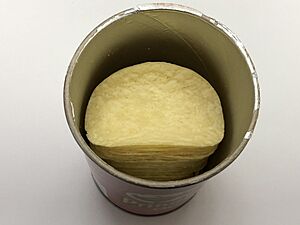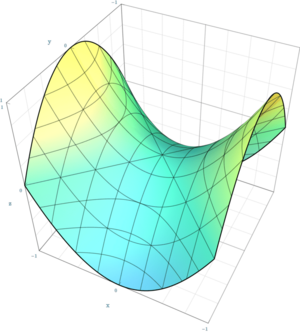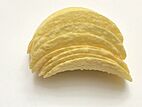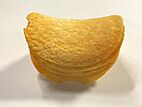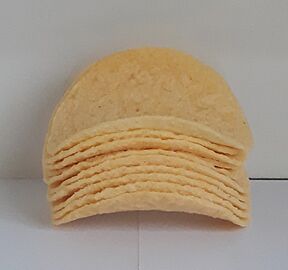Pringles facts for kids
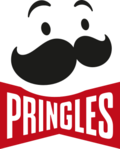
Logo with the mascot known as Julius Pringles
|
|
| Type | Potato snack |
|---|---|
| Owner | Kellanova |
| Country | United States |
| Introduced |
|
| Markets | Worldwide |
| Previous owners | Procter & Gamble (1968–2012) |
Pringles are a famous brand of stackable potato-based chips. They were first created by a company called Procter & Gamble (P&G) in 1968. These chips are special because of how they are made, which is why they are sometimes called an "extruded snack." In 2012, Pringles was sold to Kellanova, which is part of Kellogg's. More recently, in 2024, Kellanova agreed to be bought by Mars Inc..
Pringles are very popular around the world. As of 2011, you could find them in more than 140 countries! In 2012, Pringles was the fourth most popular snack brand globally, right after other big names like Lay's, Doritos, and Cheetos.
Contents
The Story of Pringles
Back in 1956, Procter & Gamble wanted to create a new kind of potato chip. People often complained that regular chips were broken, greasy, or stale. They also didn't like finding too much air in the bags. A chemist named Fredric J. Baur was given the job to fix these problems.
Baur spent two years working on a new chip. He came up with the unique saddle shape that Pringles have today. This shape is known in math as a hyperbolic paraboloid. He also designed the tube-shaped can to keep the chips safe. However, Baur couldn't make the chips taste good enough, so he moved to another project.
In the mid-1960s, another P&G scientist, Alexander Liepa, continued Baur's work. Liepa successfully made the chips taste much better. Even though Baur designed the shape, Liepa's name is on the patent for the improved taste. A mechanical engineer and author named Gene Wolfe also helped create the machine that cooked the chips.
When Pringles First Appeared
P&G first started selling Pringles in Indiana in 1968. The very first advertisement for "Pringle Potato Chips" appeared in a newspaper on October 3, 1968. After that, Pringles slowly became available across the United States. By 1975, most of the country could buy them. By 1991, Pringles were sold all over the world.
How Pringles Got Its Name
There are a few ideas about where the name "Pringles" came from. One idea is that it came from a person named Mark Pringle. He had filed a patent in 1937 for a way to process potatoes. P&G used his work when they filed their own patent for improving the taste of their potato chips.
Another idea is that two P&G advertising employees lived on Pringle Drive in Ohio. They thought the name sounded good with "potato chips." Some say the name was simply chosen from a Cincinnati phone book, or even "chosen out of a hat" to sound like a family name.
Chips or Crisps?
When Pringles first came out, they were called "Pringle's Newfangled Potato Chips." But other snack companies argued that Pringles weren't true "potato chips." This was because Pringles are made from a potato-based dough, not sliced directly from whole potatoes.
The US Food and Drug Administration (FDA) got involved. In 1975, they decided that Pringles could only use the word "chip" if they said "potato chips made from dried potatoes." This was a very long name! So, Pringles decided to call their product "crisps" instead of chips.
In the United Kingdom, there was a legal case in 2008 about whether Pringles should be taxed as "crisps." P&G argued that Pringles were not crisps because they were only 42% potato and their shape wasn't natural. This ruling meant Pringles didn't have to pay a special tax. However, in 2009, a higher court changed this decision. P&G said they had been paying the tax anyway.
Who Owns Pringles Now?
In 2011, P&G planned to sell Pringles to Diamond Foods. This deal was worth about $2.35 billion. But the deal didn't happen in 2012 because of problems with Diamond's finances.
Instead, on May 31, 2012, Kellogg's officially bought Pringles for about $2.695 billion. This purchase helped Kellogg's become the second-largest snack company in the world. As of 2024, Kellanova, which is Kellogg's parent company, agreed to be bought by Mars Inc..
As of 2015, there were five Pringles factories around the world. These factories are located in Jackson, Tennessee (USA); Mechelen, Belgium; Johor, Malaysia; Kutno, Poland; and Fujian, China.
What Pringles Are Made Of
Pringles are made of about 42% potato. The rest of the chip is made from other ingredients like wheat starch and flours from corn and rice. They also contain vegetable oils, an emulsifier (which helps ingredients mix), salt, and different seasonings.
Some other ingredients you might find in Pringles, depending on the flavor, include sweeteners like maltodextrin and dextrose, and flavor enhancers like monosodium glutamate (MSG). They can also have things like sour cream, cheddar cheese, and different natural and artificial flavors.
Pringles also make "tortilla" and "multi-grain" types. These have some of their potato replaced with corn flour, rice, wheat bran, black beans, and barley flour. In the past, there were "Corn Pringles" and "Rice Pringles" too, but these are not made anymore.
Pringles Nutrition Facts
A single serving of about 15 Original Pringles contains 150 calories. It also has 2.5 grams of saturated fat, 150 milligrams of sodium, 110 milligrams of potassium, and 1 gram of protein.
Pringles Flavors
Pringles come in many different flavors! For a long time, only the original flavor was available in the US. But now, common flavors include original, salt and vinegar, sour cream and onion, cheddar cheese, ranch dressing, barbecue, hot and spicy, and loaded baked potato.
Some flavors are only sold in certain parts of the world. For example, you might find prawn cocktail, wasabi, and curry flavors in the United Kingdom and Ireland.
Pringles also sometimes makes special "limited edition" flavors. These can be seasonal, like ketchup, zesty lime and chili, or pizza. Other past limited flavors include jalapeño, honey mustard, and screamin' dill pickle. In 2012, they even had holiday flavors like peppermint white chocolate, cinnamon sugar, and "pumpkin pie spice".
In Asia, you might find unique flavors like soft-shelled crab, grilled shrimp, seaweed, "blueberry and hazelnut", and "lemon and sesame". The grilled shrimp chips are pink, and the seaweed ones are green!
How Pringles Are Advertised
Pringles uses a famous slogan in many countries: "Once you pop, the fun don't stop!" This is a newer version of their original slogan, "Once you pop, you can't stop!"
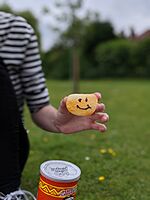
The very first Pringles TV commercials were made in 1968. In their early ads, Pringles highlighted how their chips stayed fresh and unbroken in the can. They also showed that the can held as many chips as a large bag, and that their curvy shape made them easy to stack. This led to the slogan, "Other potato chips just don't stack up."
In the 1980s, Pringles had a catchy jingle that went, "Once you taste the flavor, then you get the fever, then you've got the fever for the flavor of a Pringle!"
Since the late 1990s, Pringles ads often compare their chips to regular bagged chips. These ads usually show people enjoying Pringles, while someone else struggles with greasy, broken chips from a bag. The person with the bag often ends up wiping grease on their clothes!
Pringles are also known for their unique packaging: a tube-shaped paperboard can with a foil lining and a plastic lid that can be closed again. This special can was invented by Fredric J. Baur, the same person who helped create the chip's shape. In a unique request, Baur's children honored his wish to be buried with some of his ashes in a Pringles can.
The Pringles can has been criticized because it's hard to recycle due to being made of many different materials.
In 2021, Pringles did a fun campaign where a character from a video game called West of Dead seemed to come out of the screen during a live Twitch stream!
Kellogg's has also used the fact that Pringles chips have been studied using supercomputers to make them perfect. They even used this idea in a Pringles advertisement campaign in 2022.
Pringles Logo and Mascot
The Pringles logo features a cartoon drawing of a man's head. He has a big mustache and hair parted in the middle. This character is known as "Mr. P."
For a while, the mascot didn't have a first name. But in 2006, someone on Wikipedia added the name "Julius" to the Pringles article as a joke. Other news places picked up this name, and people even made a Facebook page to spread the idea. By 2013, the name "Julius Pringles" had become so popular that Kellogg's officially recognized it as the mascot's full name!
See also
 In Spanish: Pringles para niños
In Spanish: Pringles para niños
Images for kids
-
Pringles Christmas tree in Spinningfields, Manchester, England in 2014


